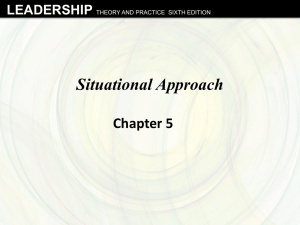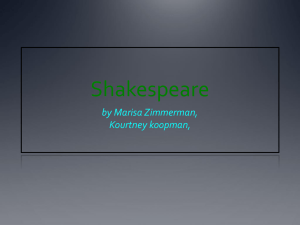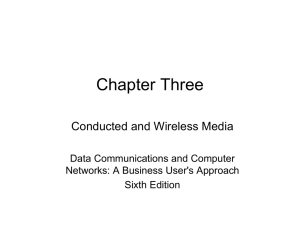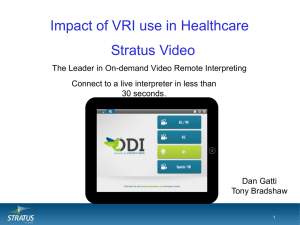Chapter 5
advertisement
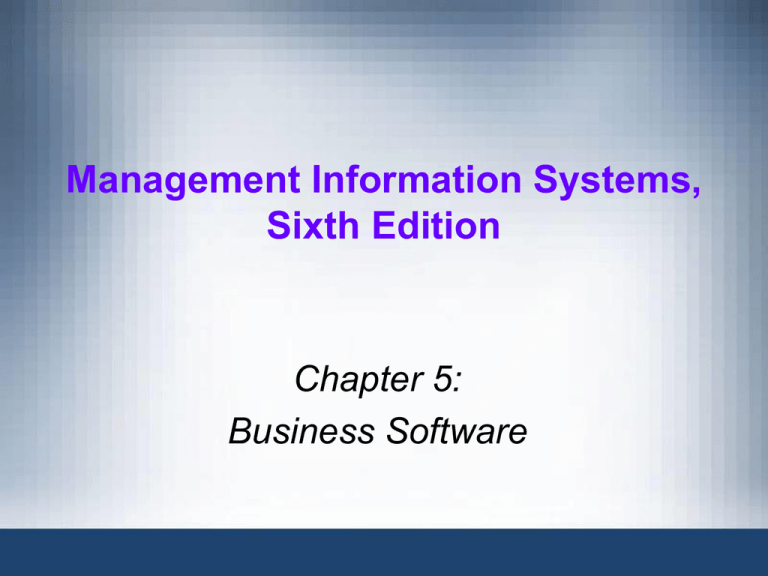
Management Information Systems, Sixth Edition Chapter 5: Business Software Objectives • Explain the difference between application software and system software • Enumerate the different generations of programming languages and explain how they differ • Cite the latest major developments in application and system software • Identify and explain the roles of Web programming languages Management Information Systems, Sixth Edition 2 Objectives (continued) • Explain the types and uses of Web site design tools • Clarify the differences between proprietary software and open source software • List characteristics that are important in evaluating packaged software applications for business use • Understand the problem of software piracy and how it affects businesses and consumers Management Information Systems, Sixth Edition 3 Software: Instructions to the Hardware • Applications: computer programs that contribute to productivity • Software: a series of instructions to a computer to execute processes • Two major categories of software: – Application software: enables task completion – System software: • Enables applications to run on a computer • Manages components and devices Management Information Systems, Sixth Edition 4 Programming Languages and Software Development Tools • Programs are needed for every computer operation • Programming: process of writing programs • Machine language: the only language that hardware understands – Consists of long strings of 0s and 1s • Assembly language: easier to program than machine language because it uses words for commands • High-level programming languages: use English-like statements Management Information Systems, Sixth Edition 5 Programming Languages and Software Development Tools (continued) • Software development tools: develop software with little knowledge of programming languages • Third-generation languages (3GLs): known as “procedural” languages – Programmer must detail logical procedure – Includes languages such as COBOL, FORTRAN, BASIC, RPG, Pascal, and C – One 3GL statement = five to 10 assembly language statements Management Information Systems, Sixth Edition 6 Programming Languages and Software Development Tools (continued) • Fourth-generation languages (4GLs): use more English-like statements – – – – Speed up the development process Built around database management systems Include many preprogrammed procedures One 4GL statement = several 3GL statements • Debugging: process of locating and fixing program errors Management Information Systems, Sixth Edition 7 Management Information Systems, Sixth Edition 8 Programming Languages and Software Development Tools (continued) Management Information Systems, Sixth Edition 9 Visual Programming • Visual programming languages: create graphical screen objects by selecting icons from a palette • Common visual programming languages include: – – – – – Microsoft Visual Basic Borland Delphi Micro Focus COBOL ASNA Visual RPG Visual C++ • Developer can still work at the code level Management Information Systems, Sixth Edition 10 Visual Programming (continued) Management Information Systems, Sixth Edition 11 Object-Oriented Programming • Object-oriented programming (OOP): modular approach to programming • Advantages: – Ease of maintenance – Efficiency in application development • Object: contains data elements (data members) and the methods to manipulate that data – Data members can only be accessed through the object’s methods Management Information Systems, Sixth Edition 12 Object-Oriented Programming (continued) • Objects are reusable and are combined to create complex programs • Popular OOP languages include Smalltalk, C++, Object Pascal, and Java • Increasing amount of software developed for the Web using languages such as Java, JavaScript, J2EE, and PHP • Applet: code produced by a Web programming language – Runs same way on different operating systems Management Information Systems, Sixth Edition 13 Object-Oriented Programming (continued) Management Information Systems, Sixth Edition 14 Language Translation: Compilers and Interpreters • Source code: program as originally written by the developer • Object code: program in machine language that can be run by the computer • Procedural languages need programs to translate source code to object code • Two types of language translators: – Compilers – Interpreters Management Information Systems, Sixth Edition 15 Language Translation: Compilers and Interpreters (continued) • Compiler: translates entire source code to object code but does not execute the code – Scans for syntax errors – Generates error messages if syntax errors found • Interpreter: scans one statement at a time – If error-free, interprets and executes the statement – Goes through the program until an error or end of program is encountered Management Information Systems, Sixth Edition 16 Language Translation: Compilers and Interpreters (continued) Management Information Systems, Sixth Edition 17 Application Software • Application software allows nonprogrammers to develop their own tools • Application-specific software: programs designed to perform specific jobs • General-purpose application software: programs that serve multiple purposes – Usually comes as packaged software • Packaged software: software that is ready to install from external storage media such as CDs Management Information Systems, Sixth Edition 18 Office Productivity Applications • Productivity tools: assist normal office work – Include word processors, spreadsheets, presentation tools, file/database software, graphics programs, desktop publishing tools, and project management applications • Word processors: used to create text documents • Spreadsheets: store numbers and perform complex mathematical, statistical, and financial analysis functions Management Information Systems, Sixth Edition 19 Office Productivity Applications (continued) • Presentation tools: develop impressive presentations quickly • File/database management tools: create and manipulate local or shared databases • Graphics programs: create intricate graphical images and manipulate digital photographs • Desktop publishing tools: develop items for publication, such as pamphlets, newsletters, cards, calendars, etc. Management Information Systems, Sixth Edition 20 Office Productivity Applications (continued) • Project management tools: help plan projects and track progress • Suite: collection of various applications that perform multiple interrelated functions – Includes Microsoft Office, Lotus SmartSuite, OpenOffice.org, ThinkFree Management Information Systems, Sixth Edition 21 Hypermedia and Multimedia • Hypermedia: a feature that enables users to access information by clicking text or graphics • Web page authoring tools: enable hypermedia features – Often part of other applications such as word processors and presentation tools Management Information Systems, Sixth Edition 22 Hypermedia and Multimedia (continued) • Multimedia software: handles many different types of data • Often used in: – Education: lessons presented in multimedia – Training exercises – Compiling and integrating data for business situations Management Information Systems, Sixth Edition 23 Mashups • Mashup: an integrated application containing some or all features from several applications – Provides enhanced features for the end user • Web site design tools: used to change the content of Web pages – Includes FrontPage, SharePoint Designer, Expression Web from Microsoft, Adobe Dreamweaver, and GoLive Management Information Systems, Sixth Edition 24 Groupware • Groupware: an application that enables workers to collaborate in real time over Web – Integration of multimedia technology and Web technology – Allows for remote collaboration – Eliminates travel times and facilitates expression and exchange of ideas Management Information Systems, Sixth Edition 25 Virtual Reality • Virtual reality (VR): an application that mimics sensory reality using software – Simulates sight, hearing, and touch – Uses equipment such as goggles, gloves, earphones, and moving bases • VR devices provide two elements: – Immersion: user senses that she/he is surrounded by the simulated environment – Interaction: allows users to simulate changes in the environment using VR devices Management Information Systems, Sixth Edition 26 Virtual Reality (continued) • VR environment senses movement, responds to signals, and provides feedback to user • Businesses use VR to decrease cost of planning buildings, machines, and vehicles • Avatar: an imaginary figure used to represent real person • VR on the Web includes public gathering applications – Second Life: an imaginary world using avatars to allow real people to meet and communicate Management Information Systems, Sixth Edition 27 3D Geographic Software • Similar to virtual reality • Used to develop three-dimensional models of geographic locations • Models are created from land and aerial photographs • Helps with navigation when tied to global positioning system software • Useful for city planners, service agencies, tourism, and travel agencies Management Information Systems, Sixth Edition 28 System Software • System software: deals with essential operations between the user and computer such as: – – – – Loading, copying, and deleting files Managing memory resources Operating peripheral equipment Encompasses compilers and interpreters • Applications must be compatible with system software Management Information Systems, Sixth Edition 29 Operating Systems • Operating system (OS): most important program on the computer – – – – – Recognizes input from keyboard and mouse Sends output to computer display Keeps track of files and directories Runs applications Manages memory • Usually developed using low-level programming languages such as assembly languages • Also known as “platforms” Management Information Systems, Sixth Edition 30 Management Information Systems, Sixth Edition 31 Operating Systems (continued) • Application program interfaces (APIs): software included in the OS that can be used by application program developers • Utilities: perform other OS functions such as: – Hardware diagnostics – Disk check – File sorting Management Information Systems, Sixth Edition 32 Operating Systems (continued) • OS’s position in logical operation of the computer: – User interacts with user interface using menus, icons, and application commands – Application converts user input into OS commands – OS commands the CPU to carry out the operation Management Information Systems, Sixth Edition 33 Operating Systems (continued) Management Information Systems, Sixth Edition 34 Operating Systems (continued) • OS must manage the system by allocating hardware resources to applications • OS provides several services, including: – User interface – Memory allocation, including the use of virtual memory (hard disk used as an extension of RAM) – Plug-and-play (PnP): recognize and run a device as soon as it is physically attached Management Information Systems, Sixth Edition 35 Operating Systems (continued) • Driver: software that enables OS to control a device • Additional OS services include: – Database management – Networking – Security • Different computers and types of microprocessors use different OSs Management Information Systems, Sixth Edition 36 Operating Systems (continued) • Popular PC operating systems – Windows XP and Windows Vista – Linux – Mac OS • Popular network OSs that are compatible with DOS, Windows, and MAC clients include: – Netware – Windows Server • Linux: a free OS based on UNIX Management Information Systems, Sixth Edition 37 Operating Systems (continued) Management Information Systems, Sixth Edition 38 Other System Software • Other types of system software include: – – – – Compilers and interpreters Communications software Utilities Database management systems • Communications software: supports transmission and reception of data across computer networks • Utilities include antivirus programs, firewalls, and antispyware/antiadware programs Management Information Systems, Sixth Edition 39 Open Source Software • Proprietary software: sold/licensed for profit – Source code is private and not available – Developer retains all rights to the software; user purchases a license to use the software • Open source software: free source code – Developed through voluntary collaboration of programmers – Fewer bugs because many programmers review the code • Popular open source software includes Mozilla Firefox, Thunderbird, MySQL, and PERL Management Information Systems, Sixth Edition 40 Open Source Software (continued) • Not all free software is open source – Microsoft Internet Explorer is free but proprietary • Linux: best known open source OS – Includes free versions and versions that charge for support and additional features – Popular because of its versatility, but has limited number of applications that run on it – Runs on mainframes, PCs, handhelds, and electronic devices Management Information Systems, Sixth Edition 41 Software Licensing • Software is usually licensed • Licensed software: provides limited permission to use the software – Time-limited license requires annual fees • Several licensing models – Permissive model: anyone can use and sell modified versions of the software – General public license (GPL): anyone can use and make modified versions, but cannot sell modified versions for profit Management Information Systems, Sixth Edition 42 Considerations for Packaged Software • Many goals and custom requirements are considered during development process of inhouse software • Factors when purchasing large software packages are more complex, including: – – – – Cost Time to implement Cost of interrupting operations Modification costs to customize the software Management Information Systems, Sixth Edition 43 Management Information Systems, Sixth Edition 44 Summary • Software: a collective term for computer programs • Two categories of software: system or application • Programming languages and software development tools are used to develop software • Increasing amount of software is linked to the Internet • Code written in non-machine language must be translated by compilers or interpreters Management Information Systems, Sixth Edition 45 Summary (continued) • Some application programs are custom designed, and many are packaged • Office productivity tools such as word processors and spreadsheets help improve worker efficiency • Hypermedia and multimedia technology are useful for training, education, research, and business Management Information Systems, Sixth Edition 46 Summary (continued) • Groupware combines hypermedia and multimedia with Web technologies for collaboration • Virtual reality tools help build models of products and structures • Three-dimensional geographic software helps model maps and locations • Many applications support Web services and access to information on the Web Management Information Systems, Sixth Edition 47 Summary (continued) • Most important system software is operating system • Open source software is distributed freely via the Web • Software is either purchased or licensed • Purchase decisions should evaluate suitability, ease of learning, ease of use, vendor reputation, expected quality of vendor support • Software piracy is still a significant problem Management Information Systems, Sixth Edition 48


